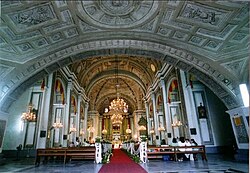Miag-ao Church
The central feature of the bas-relief facade is a large coconut tree which reaches almost to the apex. While an integral part of the Philippine landscape, the coconut tree is also the subject of lore. According to an old Philippine legend, the coconut tree was the only bequest from a loving mother to her two children, a tree which sustained them for life. On the church's facade the coconut tree appears as the "tree of life" to which St. Christopher carrying the Child Jesus on his shoulder is clinging to. The lesser facades feature the daily life of Miagaowanons during the time. Also depicted are other native flora and fauna, as well as native dress.
The church and its watchtowers were also built to defend the town and its people against raids by the Moros. It therefore has thick walls and, reportedly, secret passages. Indeed stretching along the Iloilo coast are defensive towers, but none that equal the size of the Miag-ao. It is because of this defensive purpose that it is sometimes referred to as the Miag-ao Fortress Church.Relevantní obrázky
Relevantní články
Barokní kostely FilipínBarokní kostely Filipín je označení pro čtyři hlavní barokní památky, které se nachází na Filipínách a které byly pro svou jedinečnost v roce 1993 zařazeny na Seznam světového dědictví UNESCO. Jsou to kostely ve městech Manila, Santa Maria, Paoay a Miagao a pocházejí z období španělské kolonizace Filipín. Všechny kostely jsou unikátní ukázkou evropského baroka, které bylo řemeslníky přizpůsobeno místnímu materiálu a technice. Kromě těchto 4 staveb existuje na Filipínách mnoho dalších barokních kostelů, které však na seznamu UNESCO nefigurují. .. pokračovat ve čtení





